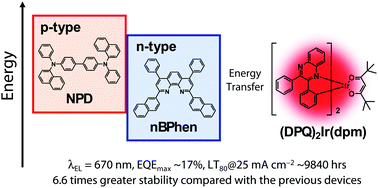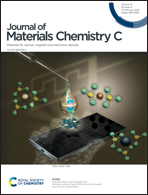Highly stable and efficient deep-red phosphorescent organic light-emitting devices using a phenanthroline derivative as an n-type exciplex host partner†
Abstract
Although deep-red illumination light sources with an emission peak wavelength over 660 nm are optimal for plant growth and health monitoring systems, the stability and efficiency of organic light-emitting diodes (OLEDs) are insufficient for practical applications. In this study, we developed a novel exciplex host system to realize highly stable and efficient deep-red OLEDs by utilizing nBPhen, a phenanthroline derivative, as the n-type exciplex host partner and a combination of (DPQ)2Ir(dpm), a deep-red iridium complex, and α-NPD, a conventional triarylamine derivative, as the p-type exciplex host partner. The proposed optimized device exhibits a lifetime that is 6.6 times longer when compared with the state-of-the-art deep-red OLEDs and maintains a high maximum external quantum efficiency of approximately 17% at a low operating voltage of 2.37 V; such a performance is considered to be among the best in the scientific literature.



 Please wait while we load your content...
Please wait while we load your content...
